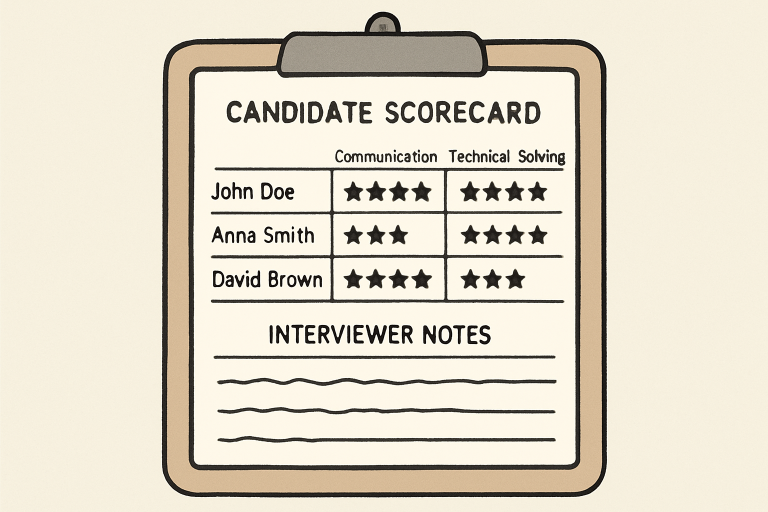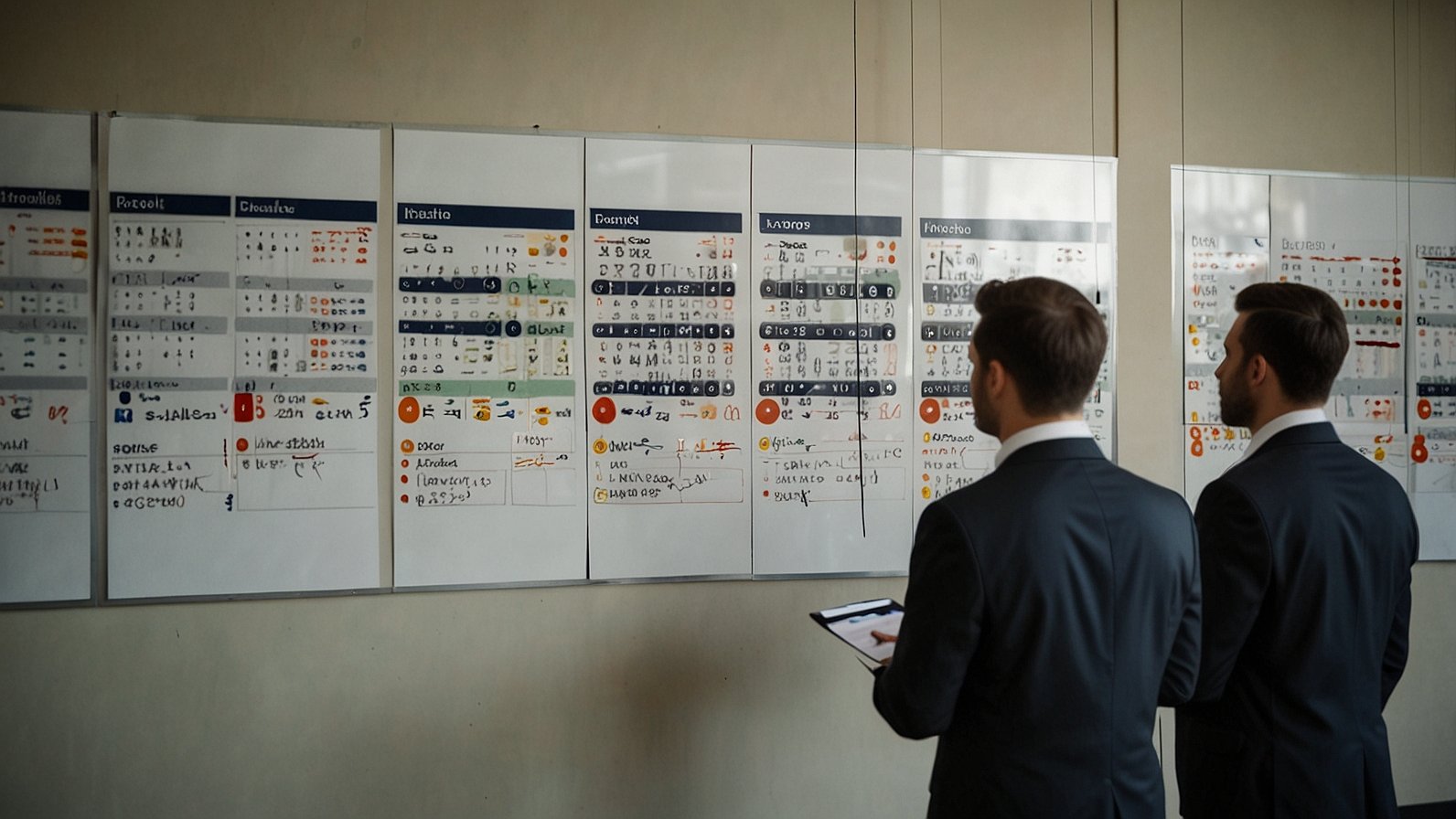Key Takeaways:
- Candidate scorecards standardize the interview process, ensuring objective and consistent evaluations.
- They help reduce unconscious bias, leading to fairer hiring decisions.
- Scorecards facilitate better collaboration among hiring teams by providing a clear framework for assessment.
- Implementing scorecards can improve the quality of hires and reduce turnover rates.
Table of Contents:
- Introduction
- What Are Candidate Scorecards?
- Benefits of Using Candidate Scorecards
- Key Components of an Effective Scorecard
- Steps to Implementing Candidate Scorecards
- Real-World Examples
- Common Challenges and Solutions
- Conclusion
Introduction
Organizations today recognize that hiring the right people is foundational to success. Yet, many hiring teams face challenges like inconsistent evaluations and subjectivity throughout the interview process. One solution to these pitfalls is implementing candidate scorecards, which create a transparent and uniform system for assessing applicants. If you want to adopt a system that enhances hiring fairness and efficiency, using an interview feedback template is a practical first step. These templates set a clear standard for how candidates are measured, ensuring that every hiring team member is aligned on what matters most for the role.
The value of standardized feedback goes beyond just documentation. With a structured approach, companies are better positioned to compare candidates equitably and eliminate biases that might otherwise influence hiring choices. As more organizations prioritize objective decision-making, introducing a robust interview feedback template into your process can lead to stronger outcomes and help build a more diverse, competent workforce.
Interview scorecards also serve as a central communication tool, especially for organizations with multiple stakeholders in hiring decisions. By establishing agreed-upon criteria and expectations from the start, scorecards foster productive discussions and streamline decision-making. In today’s competitive job market, ensuring swift, data-driven hiring can provide a crucial edge and significantly boost employee retention rates.
Implementing these tools does require some initial investment in time and training. However, studies from the Harvard Business Review show that structured interviews—supported by well-designed scorecards—improve the predictive accuracy of hiring by up to 25%, making the upfront effort well worth it in the long run.
What Are Candidate Scorecards?
Candidate scorecards are frameworks used to assess interviewees based on predetermined criteria. Each candidate is evaluated according to competencies essential for success in the role, such as technical ability, problem-solving, teamwork, and cultural fit. A well-constructed scorecard provides space for quantitative ratings and encourages interviewers to include qualitative notes, contextualizing the scores given. This consistent evaluation method improves the reliability of hiring decisions and decreases the likelihood of unintentional bias influencing the outcome.
The value of standardized feedback goes beyond just documentation. With a structured approach, companies are better positioned to compare candidates equitably and eliminate biases that might otherwise influence hiring choices. As more organizations prioritize objective decision-making, introducing a robust interview feedback template into your process can lead to stronger outcomes and help build a more diverse, competent workforce.

Benefits of Using Candidate Scorecards
- Reduces Bias in Hiring: Unstructured interviews often result in varying judgments easily swayed by first impressions or unconscious biases. Candidate scorecards help neutralize these risks by giving all candidates an equal footing.
- Improves Hiring Efficiency: Organizations that use structured hiring processes, including interview scorecards, significantly increase their chances of hiring top talent. The time saved in post-interview debriefs alone can make a substantial difference, allowing you to move the best candidates through your pipeline more efficiently.
- Enhances Collaboration: A shared evaluation framework promotes open discussion based on agreed-upon candidate strengths and weaknesses, making it easier to reach a consensus while keeping the process fair for all.
Key Components of an Effective Scorecard
- Candidate Information: Ensure each scorecard includes basic details such as the candidate’s name, the position applied for, and the interview date. This helps avoid confusion during review meetings.
- Core Competencies: Identify role-specific skills—like coding languages for engineers or leadership for managers—and general attributes like communication and adaptability.
- Rating Scale: For each criterion, use a clear and consistent scale, such as 1-5 or qualitative anchors like “Needs Improvement” to “Outstanding. “
- Behavioral Questions: Create questions encouraging candidates to demonstrate competencies through past experiences (e.g., “Describe a time when you led a team through a difficult project”).
- Interviewer Comments: Provide space for additional context, allowing interviewers to share observations or concerns not captured in ratings alone.
- Overall Recommendation: Ask for a clear hire/no-hire or graded recommendation at the end of the scorecard to guide the final decision.
Steps to Implementing Candidate Scorecards
- Identify Key Competencies: Collaborate with stakeholders and hiring managers to define success in the role, narrowing your focus to 5-8 competencies that genuinely matter.
- Develop Behavioral Questions: Write clear, open-ended questions targeting each essential skill or attribute you’ve identified.
- Establish a Rating Scale: Ensure everyone uses the same language to describe performance. This will minimize misunderstandings and simplify data analysis later.
- Train Interviewers: Conduct workshops and share best practices so that all interviewers understand how to use the scorecard effectively and consistently.
- Review and Iterate: Once you begin using scorecards, gather feedback on the process and make periodic adjustments based on what you learn. This continuous improvement ensures your system stays relevant as business needs evolve.
Real-World Examples
Leading organizations have adopted scorecards to raise the bar on talent evaluation. For example, Amazon infuses its 16 Leadership Principles into each interview, training hiring managers to anchor their feedback to specific principles with a structured scorecard. This approach helps ensure that technical skills and cultural alignment are thoroughly evaluated, maintaining high standards and consistency across thousands of hires annually. Similarly, companies like Google and other top tech firms use candidate scorecards as part of a broader commitment to evidence-based hiring. These efforts are widely cited as crucial to cultivating high-performance teams, as recognized in reporting by Forbes.
Common Challenges and Solutions
- Resistance to Change: Introducing new processes can cause hesitation amongst team members. This challenge is best addressed through hands-on training, clear communication of benefits, and leadership support to reinforce the positive impact of the change.
- Inconsistent Use: Interviewers may revert to old habits without regular reminders. Scheduling periodic audits and collecting user feedback helps ensure adherence and increases buy-in over time.
- Overcomplication: Scorecards loaded with unnecessary details can overwhelm users and hinder efficiency. To enhance ease of use, keep the tool focused on core competencies and streamline the questions and rating methods.
Conclusion
Candidate scorecards are among the most practical and effective ways to elevate your organization’s hiring maturity. Standardizing how candidates are reviewed and fostering better team collaboration, these tools reduce bias and help ensure that the right talent drives your business forward. Regular refinement of your scorecards and investment in interviewer training will keep your process robust as your company’s needs evolve, resulting in more reliable hires and lower turnover.
You May Also Read: Unlock Your Blogging Potential: Why blogsternation .com is Your Ultimate Creative Hub










